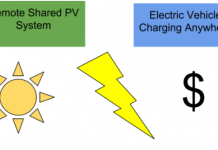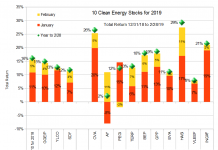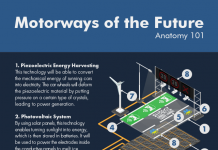Tom Konrad
I’m more than a little obsessed with finding investments which will increase with the price of oil, but not contribute to global warming. This is quite tricky, because most forms of renewable energy produce electricity, which we cannot use in our current fleet of cars. Biofuels ( even cellulosic) can be used in cars, but are limited by supply of feedstock, and by the environmental degradation that growing and collecting biofuel feedstocks can cause. Not to mention the impact on food prices (despite the fact that this may help poor farmers even as it hurts poor city-dwellers.)
A Drastic Peak Oil Scenario
When the supply of oil cannot grow to meet increasing demand, the price must increase to keep demand in check. However, the fastest growing consumers of oil are countries where the government subsidizes oil as an attempt to avoid civil unrest or political discontent. That means that demand destruction in developed markets must make up the difference for markets where demand destruction will not occur due to the lack of price signals.
How elastic is gasoline demand in North America? While there is some evidence that we are already responding to the long term rise of gas prices, demand is almost always much more elastic in the long term. Most people are more willing to skip going out to eat once a month than they are to start riding the bus. That means that a slow, gradual rise in the price of oil might be accommodated through a shift to more efficient vehicles, the construction of light rail systems, and people choosing to live more densely. On the other hand, it will take a much more drastic oil price spike (say $10 per gallon within 3 years) to pry Americans’ white knucklrideres from the steering wheels of their SUVs.
That is precisely what I expect to happen.
$10 Gas Would Mean…
People who have been cutting back on other things in order to keep up with the increasing cost of driving will not be able to afford a new Volt or Prius Plug-in Hybrid Electric Vehicle, or even my favorite, the Aptera. For people forced out of their cars by pure economics, the only options will be those that cost no more than a few thousand dollars, or even no down-payment at all.
Of all the options, mass transit has the lowest up-front cost for the user, and the only option which can be expanded quickly is bus rapid transit. Busses can typically be ordered and delivered within a year, the upfront cost is fairly low (the largest component cost of bus operation is the driver, not the cost of capital), and new routes can quickly be added by converting lanes of existing roads to dedicated bus lanes.
Long haul bus operations are already taking off in the United States. Mass transit ridership reached a new 50 year high in 2006 (I have not been able to find 2007 numbers yet.) Bus mass transit is additionally likely to be a response of municipalities to peak oil because 80% Federal funding for bus purchases to meet increased ridership or replace old busses has been available since 2005.
New Flyer Industries (NFI-UN.TO, NFYIF.PK) is the largest supplier of heavy duty busses in North America (42% delivered market share in 2007, and a 50%+ market share in terms of new orders in the last year.) They have a broad product offering, and including a wide variety of alternative fuel options, including LNG, CNG, Hybrid, and Electric options. They even have an exclusive agreement with Ballard (NASD:BLDP) to develop Hydrogen Fuel Cell busses.
The Company has a strong position in the North American market, a market which has high barriers to entry due to the need for many US buyers to "Buy American" (New Flyer qualifies), and the fact that US fleet operators are interested in an established brand with good local service. Since many American buyers only pay 20% of the capital cost (but all the service costs), service and maintenance is likely to be more important in the buying decision than the initial purchase price. This should also help push purchasers towards cleaner running busses such as New Flyer’s natural gas and hybrid versions, despite the increased capital costs.
Securities Details
New Flyer’s available securities are Income Deposit Securities (IDS), an approximate 50-50 hybrid between high yielding (but not well secured) debt and equity. Because of Canadian withholding (I have not been able to determine if this applies, but I suspect it does,) these may not be the best choice for US based tax-advantaged investors, but for Canadian and US-based taxable investors, these income deposit securities should be an excellent hedge against the rising price of gasoline. Unlike most gas price hedges available, the income from the security can directly be used to buy gas without selling even part of your original position. (Although it does have the slight disadvantage as a hedge because the mechanism is not direct, and higher gas prices may take 1-3 years to flow through to higher earnings at New Flyer.
On the subject of hedging, the company runs a very sophisticated financial operation. The unusual nature of the securities arises from their sophisticated use of the US tax code to allow deductibility of the interest part of the monthly distributions. They have fully hedged their exposure to exchange rate changes between the Canadian and US dollar (something I wish another favorite, Carmanah Technologies (CMH.TO, CMHXF) had done in recent years.) They are also taking advantage of the strong loonie (C$) to buy back some previously issued securities using excess cash and the proceeds of a new offering of additional IDS in Canada. Because of the exchange rate terms of the class B and C shares they are redeeming, this will have an immediate positive impact on cash flow.
Conclusion
From listening to the most recent conference call, I get the impression that management is very conservative, and has not built a rising oil price into their projections for market growth. None of the analysts on the call asked about the effects of rising oil prices either. In fact, management had expected the current strong market for bus orders to slack off towards the end of the year, and they were surprised that they see no signs of slackening growth.
Since management and most analysts have not incorporated peak oil into their projections, we can expect unpleasant surprises at the pump to lead to pleasant surprises during earnings announcements.
Note
Since I wrote the above, one of my New Years Speculations, Capstone Microturbine (CPST), received an order for 150 turbines for use in a fleet of hybrid busses. Although this is not a new application for their microturbines, it was one I had forgotten when looking for bus stocks.
DISCLOSURE: Tom Konrad and/or his clients have long positions in NFYIF, CMHXF, CPST.
DISCLAIMER: The information and trades provided here are for informational purposes only and are not a solicitation to buy or sell any of these securities. Investing involves substantial risk and you should evaluate your own risk levels before you make any investment. Past results are not an indication of future performance. Please take the time to read the full disclaimer here.










Affording an Aptera’s price is only the beginning – then you need to buy a gas powered car to go to any destination
out of the county.
Kerry:
Aptera is expected to offer a PHEV version.
In any case, the assumption that we all need to own the means to drive thousands of miles with only the occaisional fill-up does not bear scrutinty… if something is only needed once a year, it may make more sense to rent than to own.
Add to that car or ride sharing. Our options are certainly growing. 🙂
Very interesting blog, Tom. Thanks for the link.
Do the NFYIF.PK shares pay a dividend similar to the NFI.UN ones?? After looking at the year end statements there appear to be class A,B, and C shares -all paying dividends at different rates- but i can’t find any support that Class C is the .PK shares. Any ideas?
NFYIF and NFI.UN are the same class of shares, paying the same dividends, but trading on different exchanges.
These shares are equal to one equity share and one income unit (that is on class A + one class B (if I have the letters straight.) Most of the As and Bs are being/have been retired in preference to the combination (NFI.UN/NFYIF).
I’m a US based IRA investor who badly wants to buy NFYIF.
However my brokerage will charge me an extra $75 to buy this foreign stock.
What can I do to avoid this?
If I open a discount brokerage taxable account will I have to pay a similar fee?
D_Lane:
I can’t speak for all discount brokers, but none of the ones I have worked with charged extra for NFYIF trades. The ones I’ve placed trades to buy this stock with are Schwab, E*Trade, and Bank of America. All charged their ordinary commission, between $9 and $13, depending on the broker and the account in question.
Thanks, Tom! I think I need to get on this today.
If half the security is an interest bearing bond, what is the period of the bond, ie its maturity date?
Here’s what new flyer says: Each IDS consists of one common share of NFI (a “common share”) and C$5.53 principal amount of 14% subordinated notes of NFI ULC (the “subordinated notes”), an indirect subsidiary of NFI.
The Certificate of Amendment and Registration of Restated Articles dated 9/22/2005 states that New Flyer
Industries is an Unlimited Liability Corporation.
On pg. 12 it states that the liability of each shareholder of the ULC is unlimited in extent and joint and several in nature. This could be bad for shareholders if a bus burned because of a wiring defect or something of that nature.
Mark-
“NFI ULC”, a subsidiary of New Flyer, and the issuer of the subordinated debt portion of the IDS is an unlimited liability corp. New Flyer Industries, the issuer of the equity portion of the IDS, is a limited liability corporation. Since IDS holders do not own equity in the ULC, they are not subject to unlimited liability.
Kingsun Optoelectronic Co., Ltd is a leading company in Manufacturing the LED Lights and LED Street Lights products for more than 16 years. Kingsun LED Light products include: the LED Light, LED Street Light, LED Tunnel Light, LED Flood Light, LED Tube Light and LED High Bay Light.
Add to that car or ride sharing.